Comprehensive Corporate Accounting Analysis of RFG Financials
VerifiedAdded on 2021/06/16
|11
|2613
|21
Report
AI Summary
This report provides a detailed analysis of a corporate accounting assignment focusing on the financial statements of Retail Food Group (RFG). The report begins with an examination of the cash flow statement, dissecting the net cash flows from operations, investing activities, and financing activities, and discusses the changes in these items from 2015 to 2017. It then analyzes the other comprehensive income statement, highlighting key items such as income tax, cash flow hedge reserve, and foreign currency translation reserve. The report also delves into the accounting for corporate income tax, comparing reported tax expenses with actual tax expenses, and explaining the role of deferred tax assets and liabilities. Finally, the report concludes with an assessment of RFG's taxation treatment, noting the company's adherence to Australian taxation law and discussing the impact of deferred tax assets on tax variations. The analysis provides a comprehensive understanding of RFG's financial performance and accounting practices.
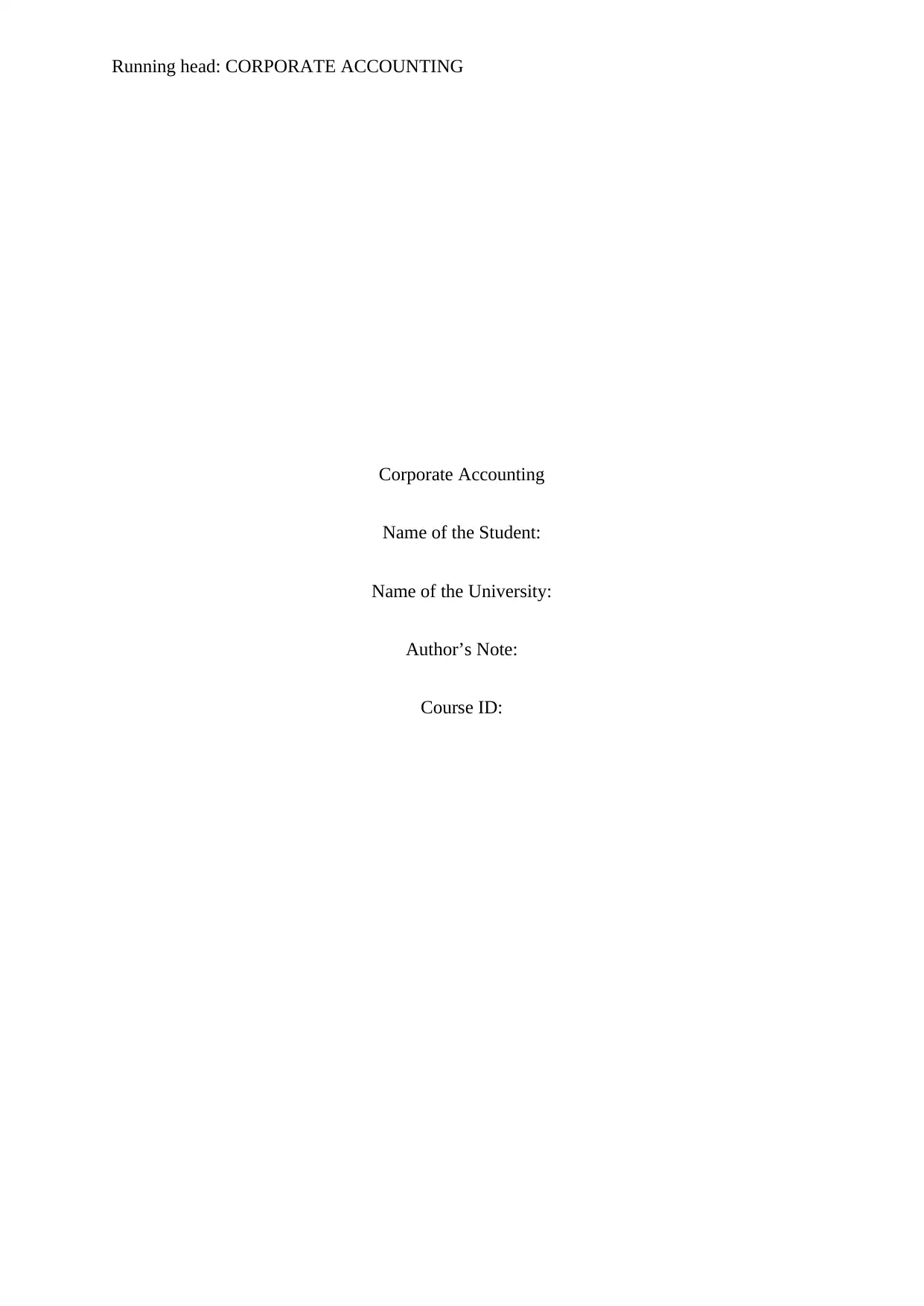
Running head: CORPORATE ACCOUNTING
Corporate Accounting
Name of the Student:
Name of the University:
Author’s Note:
Course ID:
Corporate Accounting
Name of the Student:
Name of the University:
Author’s Note:
Course ID:
Paraphrase This Document
Need a fresh take? Get an instant paraphrase of this document with our AI Paraphraser
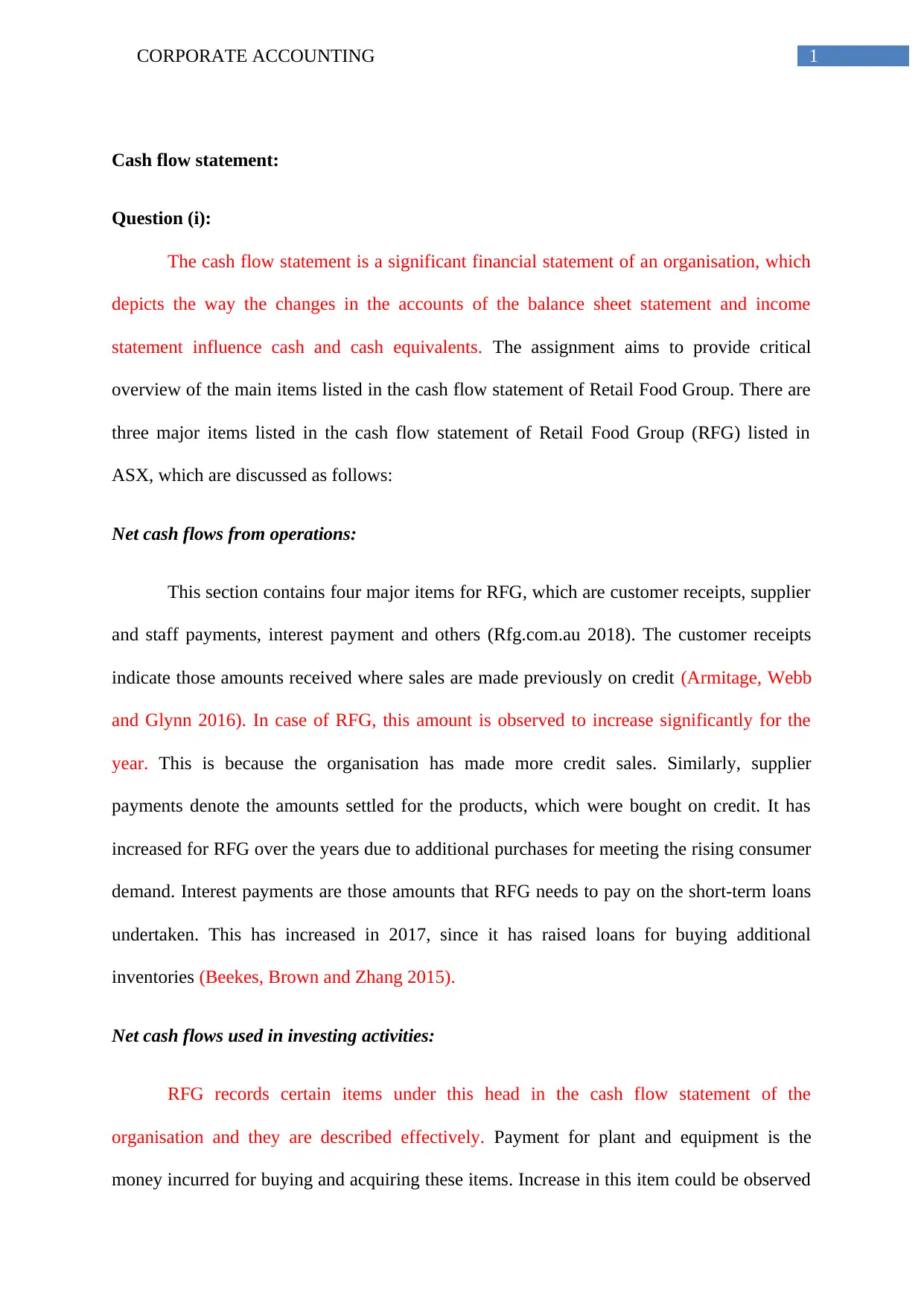
1CORPORATE ACCOUNTING
Cash flow statement:
Question (i):
The cash flow statement is a significant financial statement of an organisation, which
depicts the way the changes in the accounts of the balance sheet statement and income
statement influence cash and cash equivalents. The assignment aims to provide critical
overview of the main items listed in the cash flow statement of Retail Food Group. There are
three major items listed in the cash flow statement of Retail Food Group (RFG) listed in
ASX, which are discussed as follows:
Net cash flows from operations:
This section contains four major items for RFG, which are customer receipts, supplier
and staff payments, interest payment and others (Rfg.com.au 2018). The customer receipts
indicate those amounts received where sales are made previously on credit (Armitage, Webb
and Glynn 2016). In case of RFG, this amount is observed to increase significantly for the
year. This is because the organisation has made more credit sales. Similarly, supplier
payments denote the amounts settled for the products, which were bought on credit. It has
increased for RFG over the years due to additional purchases for meeting the rising consumer
demand. Interest payments are those amounts that RFG needs to pay on the short-term loans
undertaken. This has increased in 2017, since it has raised loans for buying additional
inventories (Beekes, Brown and Zhang 2015).
Net cash flows used in investing activities:
RFG records certain items under this head in the cash flow statement of the
organisation and they are described effectively. Payment for plant and equipment is the
money incurred for buying and acquiring these items. Increase in this item could be observed
Cash flow statement:
Question (i):
The cash flow statement is a significant financial statement of an organisation, which
depicts the way the changes in the accounts of the balance sheet statement and income
statement influence cash and cash equivalents. The assignment aims to provide critical
overview of the main items listed in the cash flow statement of Retail Food Group. There are
three major items listed in the cash flow statement of Retail Food Group (RFG) listed in
ASX, which are discussed as follows:
Net cash flows from operations:
This section contains four major items for RFG, which are customer receipts, supplier
and staff payments, interest payment and others (Rfg.com.au 2018). The customer receipts
indicate those amounts received where sales are made previously on credit (Armitage, Webb
and Glynn 2016). In case of RFG, this amount is observed to increase significantly for the
year. This is because the organisation has made more credit sales. Similarly, supplier
payments denote the amounts settled for the products, which were bought on credit. It has
increased for RFG over the years due to additional purchases for meeting the rising consumer
demand. Interest payments are those amounts that RFG needs to pay on the short-term loans
undertaken. This has increased in 2017, since it has raised loans for buying additional
inventories (Beekes, Brown and Zhang 2015).
Net cash flows used in investing activities:
RFG records certain items under this head in the cash flow statement of the
organisation and they are described effectively. Payment for plant and equipment is the
money incurred for buying and acquiring these items. Increase in this item could be observed

2CORPORATE ACCOUNTING
in 2017, since RFG has laid stress on increasing its asset base. Due to this, lower proceeds
from this item have been generated in 2017. The intangible asset payment signifies the
money that RFG has incurred in order to acquire intangible assets (Benson et al. 2015). This
amount has decreased slightly in 2017. Finally, interest payment is the sum received as
interest from investments made. Since RFG has realised adequate cash flows from the capital
invested in various projects, this item has increased considerably over the year.
Net cash flows used in financing activities:
There are various items that are disclosed under this section of the cash flow
statement for RFG and the most significant items constitute of the following:
Share issue
Amount gained from borrowings
Amount paid for borrowings (Ali 2016)
Payment related to issue of debt and share
The share issue signifies the amount earned by the organisation by accumulating funds
from the equity shareholders (Ball et al. 2016). $35,600,000 has been earned by issuing
shares in 2017; however, nothing was earned in 2016 as proceeds from this issuance. The
borrowing proceeds have increased in 2017 due to increased investment. This is because it
has adopted the strategy of repaying its borrowings from 2015. Finally, increase in dividend
payments could be identified over the years with the rise in net earnings of the organisation.
in 2017, since RFG has laid stress on increasing its asset base. Due to this, lower proceeds
from this item have been generated in 2017. The intangible asset payment signifies the
money that RFG has incurred in order to acquire intangible assets (Benson et al. 2015). This
amount has decreased slightly in 2017. Finally, interest payment is the sum received as
interest from investments made. Since RFG has realised adequate cash flows from the capital
invested in various projects, this item has increased considerably over the year.
Net cash flows used in financing activities:
There are various items that are disclosed under this section of the cash flow
statement for RFG and the most significant items constitute of the following:
Share issue
Amount gained from borrowings
Amount paid for borrowings (Ali 2016)
Payment related to issue of debt and share
The share issue signifies the amount earned by the organisation by accumulating funds
from the equity shareholders (Ball et al. 2016). $35,600,000 has been earned by issuing
shares in 2017; however, nothing was earned in 2016 as proceeds from this issuance. The
borrowing proceeds have increased in 2017 due to increased investment. This is because it
has adopted the strategy of repaying its borrowings from 2015. Finally, increase in dividend
payments could be identified over the years with the rise in net earnings of the organisation.
⊘ This is a preview!⊘
Do you want full access?
Subscribe today to unlock all pages.

Trusted by 1+ million students worldwide
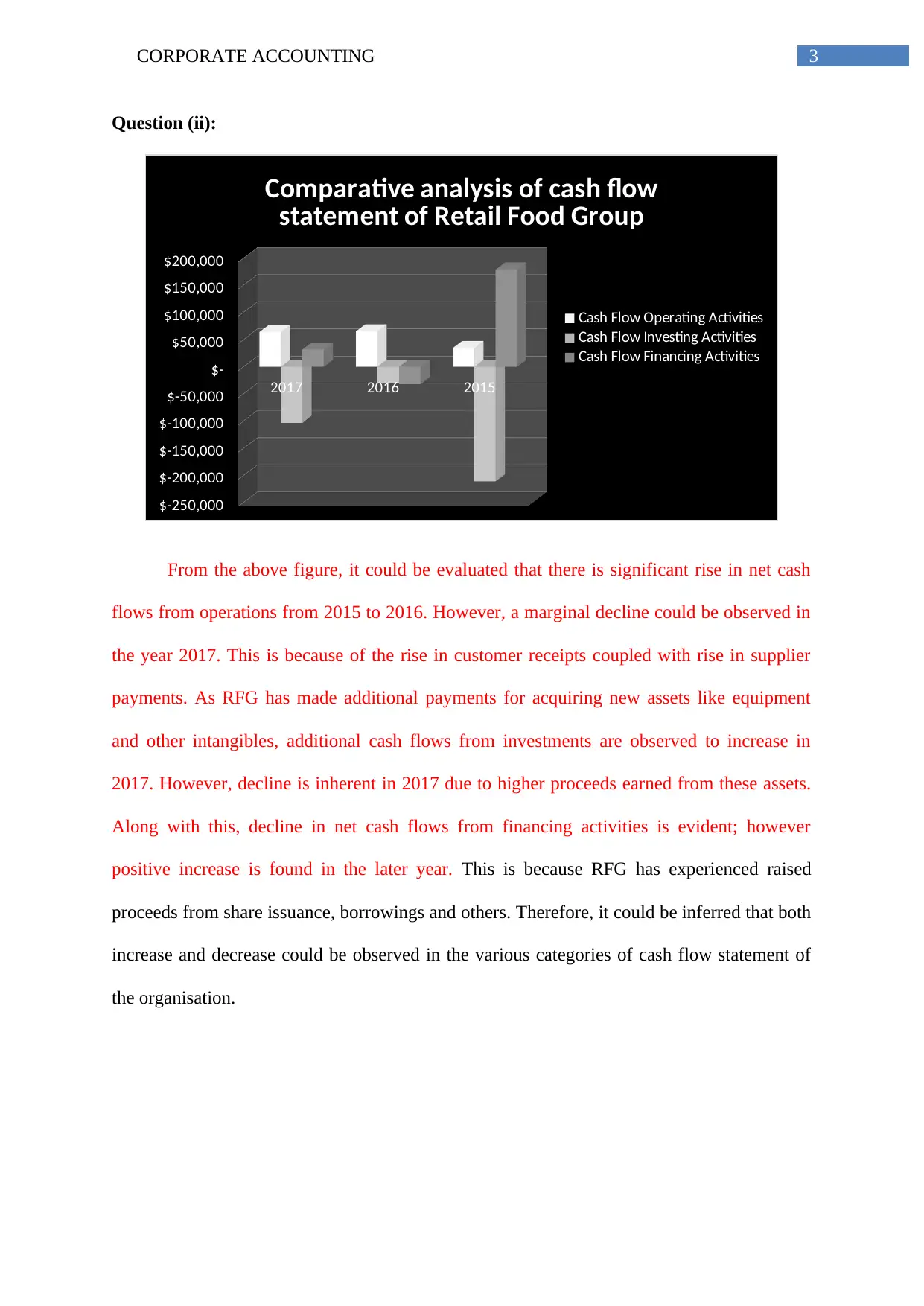
3CORPORATE ACCOUNTING
Question (ii):
2017 2016 2015
$-250,000
$-200,000
$-150,000
$-100,000
$-50,000
$-
$50,000
$100,000
$150,000
$200,000
Comparative analysis of cash flow
statement of Retail Food Group
Cash Flow Operating Activities
Cash Flow Investing Activities
Cash Flow Financing Activities
From the above figure, it could be evaluated that there is significant rise in net cash
flows from operations from 2015 to 2016. However, a marginal decline could be observed in
the year 2017. This is because of the rise in customer receipts coupled with rise in supplier
payments. As RFG has made additional payments for acquiring new assets like equipment
and other intangibles, additional cash flows from investments are observed to increase in
2017. However, decline is inherent in 2017 due to higher proceeds earned from these assets.
Along with this, decline in net cash flows from financing activities is evident; however
positive increase is found in the later year. This is because RFG has experienced raised
proceeds from share issuance, borrowings and others. Therefore, it could be inferred that both
increase and decrease could be observed in the various categories of cash flow statement of
the organisation.
Question (ii):
2017 2016 2015
$-250,000
$-200,000
$-150,000
$-100,000
$-50,000
$-
$50,000
$100,000
$150,000
$200,000
Comparative analysis of cash flow
statement of Retail Food Group
Cash Flow Operating Activities
Cash Flow Investing Activities
Cash Flow Financing Activities
From the above figure, it could be evaluated that there is significant rise in net cash
flows from operations from 2015 to 2016. However, a marginal decline could be observed in
the year 2017. This is because of the rise in customer receipts coupled with rise in supplier
payments. As RFG has made additional payments for acquiring new assets like equipment
and other intangibles, additional cash flows from investments are observed to increase in
2017. However, decline is inherent in 2017 due to higher proceeds earned from these assets.
Along with this, decline in net cash flows from financing activities is evident; however
positive increase is found in the later year. This is because RFG has experienced raised
proceeds from share issuance, borrowings and others. Therefore, it could be inferred that both
increase and decrease could be observed in the various categories of cash flow statement of
the organisation.
Paraphrase This Document
Need a fresh take? Get an instant paraphrase of this document with our AI Paraphraser
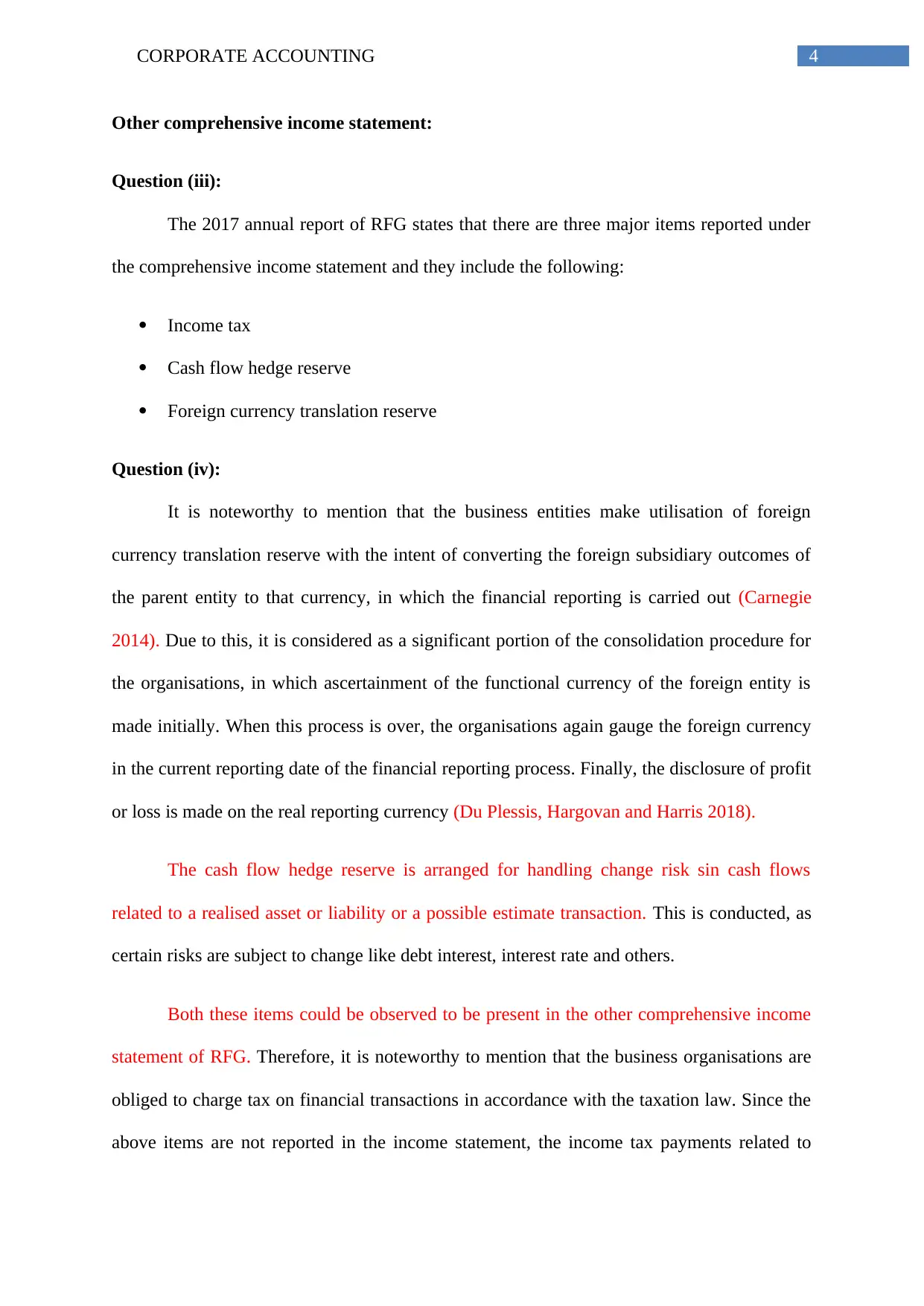
4CORPORATE ACCOUNTING
Other comprehensive income statement:
Question (iii):
The 2017 annual report of RFG states that there are three major items reported under
the comprehensive income statement and they include the following:
Income tax
Cash flow hedge reserve
Foreign currency translation reserve
Question (iv):
It is noteworthy to mention that the business entities make utilisation of foreign
currency translation reserve with the intent of converting the foreign subsidiary outcomes of
the parent entity to that currency, in which the financial reporting is carried out (Carnegie
2014). Due to this, it is considered as a significant portion of the consolidation procedure for
the organisations, in which ascertainment of the functional currency of the foreign entity is
made initially. When this process is over, the organisations again gauge the foreign currency
in the current reporting date of the financial reporting process. Finally, the disclosure of profit
or loss is made on the real reporting currency (Du Plessis, Hargovan and Harris 2018).
The cash flow hedge reserve is arranged for handling change risk sin cash flows
related to a realised asset or liability or a possible estimate transaction. This is conducted, as
certain risks are subject to change like debt interest, interest rate and others.
Both these items could be observed to be present in the other comprehensive income
statement of RFG. Therefore, it is noteworthy to mention that the business organisations are
obliged to charge tax on financial transactions in accordance with the taxation law. Since the
above items are not reported in the income statement, the income tax payments related to
Other comprehensive income statement:
Question (iii):
The 2017 annual report of RFG states that there are three major items reported under
the comprehensive income statement and they include the following:
Income tax
Cash flow hedge reserve
Foreign currency translation reserve
Question (iv):
It is noteworthy to mention that the business entities make utilisation of foreign
currency translation reserve with the intent of converting the foreign subsidiary outcomes of
the parent entity to that currency, in which the financial reporting is carried out (Carnegie
2014). Due to this, it is considered as a significant portion of the consolidation procedure for
the organisations, in which ascertainment of the functional currency of the foreign entity is
made initially. When this process is over, the organisations again gauge the foreign currency
in the current reporting date of the financial reporting process. Finally, the disclosure of profit
or loss is made on the real reporting currency (Du Plessis, Hargovan and Harris 2018).
The cash flow hedge reserve is arranged for handling change risk sin cash flows
related to a realised asset or liability or a possible estimate transaction. This is conducted, as
certain risks are subject to change like debt interest, interest rate and others.
Both these items could be observed to be present in the other comprehensive income
statement of RFG. Therefore, it is noteworthy to mention that the business organisations are
obliged to charge tax on financial transactions in accordance with the taxation law. Since the
above items are not reported in the income statement, the income tax payments related to

5CORPORATE ACCOUNTING
these items are not reported in the income statement of RFG as well (Gray, Harymawan and
Nowland 2016).
Question (v):
The investors often analyse the income statement of an organisation so that adequate
understanding could be obtained regarding the net earnings. Previously, the net earnings
variation is a consideration of the external factors of the core business operations and
significant volatility was encountered on the part of the shareholders for their investments.
However, RFG provides all the minute details of all the items listed in the comprehensive
income statement. Hence, this statement is a mix of standard net earnings and other
comprehensive income. In other words, this statement supplies a holistic and detailed account
of all those items, which could not be reported in the income statement of the organisation.
Thus, by combining all these reasons, the three stated items are not disclosed in the
consolidated income statement of RFG.
Accounting for corporate income tax:
Question (vi):
It needs to be mentioned that RFG needs to make tax payments in accordance with the
Australian taxation law. As per its annual report in 2017, the earnings before tax have been
$87,613,000 as opposed to $76,583,000 in 2016. Thus, RFG needs to apply the corporate tax
rate of 30% prevalent in Australia on the above-stated amounts. This would help the
organisation to obtain the net income of the organisation in both the years. However, the
taxation expense, as disclosed in the annual report of RFG, has been $25,686,000 in 2017 as
opposed to $23,620,000 in 2016.
these items are not reported in the income statement of RFG as well (Gray, Harymawan and
Nowland 2016).
Question (v):
The investors often analyse the income statement of an organisation so that adequate
understanding could be obtained regarding the net earnings. Previously, the net earnings
variation is a consideration of the external factors of the core business operations and
significant volatility was encountered on the part of the shareholders for their investments.
However, RFG provides all the minute details of all the items listed in the comprehensive
income statement. Hence, this statement is a mix of standard net earnings and other
comprehensive income. In other words, this statement supplies a holistic and detailed account
of all those items, which could not be reported in the income statement of the organisation.
Thus, by combining all these reasons, the three stated items are not disclosed in the
consolidated income statement of RFG.
Accounting for corporate income tax:
Question (vi):
It needs to be mentioned that RFG needs to make tax payments in accordance with the
Australian taxation law. As per its annual report in 2017, the earnings before tax have been
$87,613,000 as opposed to $76,583,000 in 2016. Thus, RFG needs to apply the corporate tax
rate of 30% prevalent in Australia on the above-stated amounts. This would help the
organisation to obtain the net income of the organisation in both the years. However, the
taxation expense, as disclosed in the annual report of RFG, has been $25,686,000 in 2017 as
opposed to $23,620,000 in 2016.
⊘ This is a preview!⊘
Do you want full access?
Subscribe today to unlock all pages.

Trusted by 1+ million students worldwide

6CORPORATE ACCOUNTING
Question (vii):
The above evaluation makes it evident that difference could be observed between the
reported taxation expense and the tax expense, which would be actually charged by applying
30% tax rate. Certain reasons could be there that the tax expense reported does not resemble
the actual tax expense. In order to determine taxable income, it is necessary to take into
consideration the non-deductible expenses. This is because they are added with the taxable
amount as $879,000 in 2017 and $638,000 in 2016. The varying tax rate is another reason
(Henderson et al. 2015). In Australia, the tax rate is 28%; however, for the business
subsidiaries are 28% and 34% respectively. Since deferred tax assets are realised in the
reporting year, it is obvious that the actual tax amount would vary from the reported one, as
the organisation aims to obtain tax advantages. When this aspect is present, $177,000 is
deducted from the tax expense of the organisation. All these factors have led to difference
between reported tax expense and actual tax expense (Kenny and Larson 2018).
Question (viii):
RFG discloses all the necessary details about its items as financial notes in its annual
report. Deferred tax assets and deferred tax liabilities are considered as a part of these items
in its published annual report. Deferred tax assets have been $13,657,000 in 2017, which
were $7,394,000 in 2016. The deferred tax liabilities have been $119,433,000 in 2017 as
opposed to $115,908,000 in 2016.
The role of deferred tax assets and deferred tax liabilities is immense in the context of
the business organisation and RFG records them for a number of causes. Deferred tax assets
are recorded due to excess payment of depreciation because of the variation in rate of tax
depreciation and actual rate of depreciation. The primary reason behind recording deferred
tax liabilities is the variation in the profit of RFG, as lower tax payments are made (Newberry
2015).
Question (vii):
The above evaluation makes it evident that difference could be observed between the
reported taxation expense and the tax expense, which would be actually charged by applying
30% tax rate. Certain reasons could be there that the tax expense reported does not resemble
the actual tax expense. In order to determine taxable income, it is necessary to take into
consideration the non-deductible expenses. This is because they are added with the taxable
amount as $879,000 in 2017 and $638,000 in 2016. The varying tax rate is another reason
(Henderson et al. 2015). In Australia, the tax rate is 28%; however, for the business
subsidiaries are 28% and 34% respectively. Since deferred tax assets are realised in the
reporting year, it is obvious that the actual tax amount would vary from the reported one, as
the organisation aims to obtain tax advantages. When this aspect is present, $177,000 is
deducted from the tax expense of the organisation. All these factors have led to difference
between reported tax expense and actual tax expense (Kenny and Larson 2018).
Question (viii):
RFG discloses all the necessary details about its items as financial notes in its annual
report. Deferred tax assets and deferred tax liabilities are considered as a part of these items
in its published annual report. Deferred tax assets have been $13,657,000 in 2017, which
were $7,394,000 in 2016. The deferred tax liabilities have been $119,433,000 in 2017 as
opposed to $115,908,000 in 2016.
The role of deferred tax assets and deferred tax liabilities is immense in the context of
the business organisation and RFG records them for a number of causes. Deferred tax assets
are recorded due to excess payment of depreciation because of the variation in rate of tax
depreciation and actual rate of depreciation. The primary reason behind recording deferred
tax liabilities is the variation in the profit of RFG, as lower tax payments are made (Newberry
2015).
Paraphrase This Document
Need a fresh take? Get an instant paraphrase of this document with our AI Paraphraser

7CORPORATE ACCOUNTING
Question (ix):
Income tax payable could not be found in the annual report of 2017 for RFG;
however, this item is present in 2016 amounting to $4,455,000. No similarity could be found
in income tax expense and income tax payable due to a wide variety of reasons. Out of them,
deferred tax assets are one reason (Rao and Tilt 2016). It is observed that the organisations
incur additional tax as opposed to the actual tax expense. Since, the organisation has paid
excess amount as tax, it has lead to formation of deferred tax assets. Moreover, the
regulations in Australia are not same for tax accounting and financial accounting. For
instance, difference in depreciation expense could be observed because of the variations in
accounting rules (Sultana 2015).
Question (x):
RFG has reported taxation expense of $25,686,000 in 2017 and $23,620,000 in 2016
in the income statement, while in the cash flow statement, the tax expenses are $21,460,000
in 2017 as opposed to $19,298,000 in 2016. There are particular reasons that have resulted in
such difference. For computing the income tax expense; initially, RFG has applied the
standard tax rate of 30% on the operating income before tax. However, it is treated in the
operating cash flows as income tax payable. This signifies the income tax payment as the
satisfaction of the existing obligations of the organisation (Tucker and Schaltegger 2016).
The total amount of income tax paid in the year 2017 is reported in the income statement of
RFG. However, for taxation expenses in the cash flow statement, the previous year tax
payment or future year tax payment is considered. Due to all these reasons, the main variation
could be viewed under the taxation expenses.
Question (xi):
Based on the above evaluation, it could be evaluated that no confusing or surprising
elements could be found out in the taxation treatment of RFG, as it has conducted its tax
Question (ix):
Income tax payable could not be found in the annual report of 2017 for RFG;
however, this item is present in 2016 amounting to $4,455,000. No similarity could be found
in income tax expense and income tax payable due to a wide variety of reasons. Out of them,
deferred tax assets are one reason (Rao and Tilt 2016). It is observed that the organisations
incur additional tax as opposed to the actual tax expense. Since, the organisation has paid
excess amount as tax, it has lead to formation of deferred tax assets. Moreover, the
regulations in Australia are not same for tax accounting and financial accounting. For
instance, difference in depreciation expense could be observed because of the variations in
accounting rules (Sultana 2015).
Question (x):
RFG has reported taxation expense of $25,686,000 in 2017 and $23,620,000 in 2016
in the income statement, while in the cash flow statement, the tax expenses are $21,460,000
in 2017 as opposed to $19,298,000 in 2016. There are particular reasons that have resulted in
such difference. For computing the income tax expense; initially, RFG has applied the
standard tax rate of 30% on the operating income before tax. However, it is treated in the
operating cash flows as income tax payable. This signifies the income tax payment as the
satisfaction of the existing obligations of the organisation (Tucker and Schaltegger 2016).
The total amount of income tax paid in the year 2017 is reported in the income statement of
RFG. However, for taxation expenses in the cash flow statement, the previous year tax
payment or future year tax payment is considered. Due to all these reasons, the main variation
could be viewed under the taxation expenses.
Question (xi):
Based on the above evaluation, it could be evaluated that no confusing or surprising
elements could be found out in the taxation treatment of RFG, as it has conducted its tax

8CORPORATE ACCOUNTING
operations with full adherence to the taxation law of Australia. However, it could be an
interesting factor in observing the way where RFG has conducted its taxation expense. The
availability of deferred tax assets is a primary reason for the variations, as RFG could enjoy
tax benefits. Therefore, after careful observation of tax-related accounting of RFG, an in-
depth knowledge could be obtained regarding the ways of performing the tax-related
operations of the organisations.
operations with full adherence to the taxation law of Australia. However, it could be an
interesting factor in observing the way where RFG has conducted its taxation expense. The
availability of deferred tax assets is a primary reason for the variations, as RFG could enjoy
tax benefits. Therefore, after careful observation of tax-related accounting of RFG, an in-
depth knowledge could be obtained regarding the ways of performing the tax-related
operations of the organisations.
⊘ This is a preview!⊘
Do you want full access?
Subscribe today to unlock all pages.

Trusted by 1+ million students worldwide

9CORPORATE ACCOUNTING
References:
Ali, S., 2016. Corporate governance and stock liquidity in Australia: A pitch.
Armitage, H.M., Webb, A. and Glynn, J., 2016. The use of management accounting
techniques by small and medium‐sized enterprises: a field study of Canadian and Australian
practice. Accounting Perspectives, 15(1), pp.31-69.
Beekes, W., Brown, P. and Zhang, Q., 2015. Corporate governance and the informativeness
of disclosures in Australia: A re‐examination. Accounting & Finance, 55(4), pp.931-963.
Benson, K., Clarkson, P.M., Smith, T. and Tutticci, I., 2015. A review of accounting research
in the Asia Pacific region. Australian Journal of Management, 40(1), pp.36-88.
Carnegie, G., 2014. Pastoral accounting in colonial Australia: a case study of unregulated
accounting. Routledge.
Du Plessis, J.J., Hargovan, A. and Harris, J., 2018. Principles of contemporary corporate
governance. Cambridge University Press.
Gray, S., Harymawan, I. and Nowland, J., 2016. Political and government connections on
corporate boards in Australia: Good for business?. Australian Journal of Management, 41(1),
pp.3-26.
Henderson, S., Peirson, G., Herbohn, K. and Howieson, B., 2015. Issues in financial
accounting. Pearson Higher Education AU.
Kenny, S.Y. and Larson, R.K., 2018. A review and analysis of Advances in International
Accounting research. Journal of International Accounting, Auditing and Taxation, 30,
pp.117-126.
References:
Ali, S., 2016. Corporate governance and stock liquidity in Australia: A pitch.
Armitage, H.M., Webb, A. and Glynn, J., 2016. The use of management accounting
techniques by small and medium‐sized enterprises: a field study of Canadian and Australian
practice. Accounting Perspectives, 15(1), pp.31-69.
Beekes, W., Brown, P. and Zhang, Q., 2015. Corporate governance and the informativeness
of disclosures in Australia: A re‐examination. Accounting & Finance, 55(4), pp.931-963.
Benson, K., Clarkson, P.M., Smith, T. and Tutticci, I., 2015. A review of accounting research
in the Asia Pacific region. Australian Journal of Management, 40(1), pp.36-88.
Carnegie, G., 2014. Pastoral accounting in colonial Australia: a case study of unregulated
accounting. Routledge.
Du Plessis, J.J., Hargovan, A. and Harris, J., 2018. Principles of contemporary corporate
governance. Cambridge University Press.
Gray, S., Harymawan, I. and Nowland, J., 2016. Political and government connections on
corporate boards in Australia: Good for business?. Australian Journal of Management, 41(1),
pp.3-26.
Henderson, S., Peirson, G., Herbohn, K. and Howieson, B., 2015. Issues in financial
accounting. Pearson Higher Education AU.
Kenny, S.Y. and Larson, R.K., 2018. A review and analysis of Advances in International
Accounting research. Journal of International Accounting, Auditing and Taxation, 30,
pp.117-126.
Paraphrase This Document
Need a fresh take? Get an instant paraphrase of this document with our AI Paraphraser
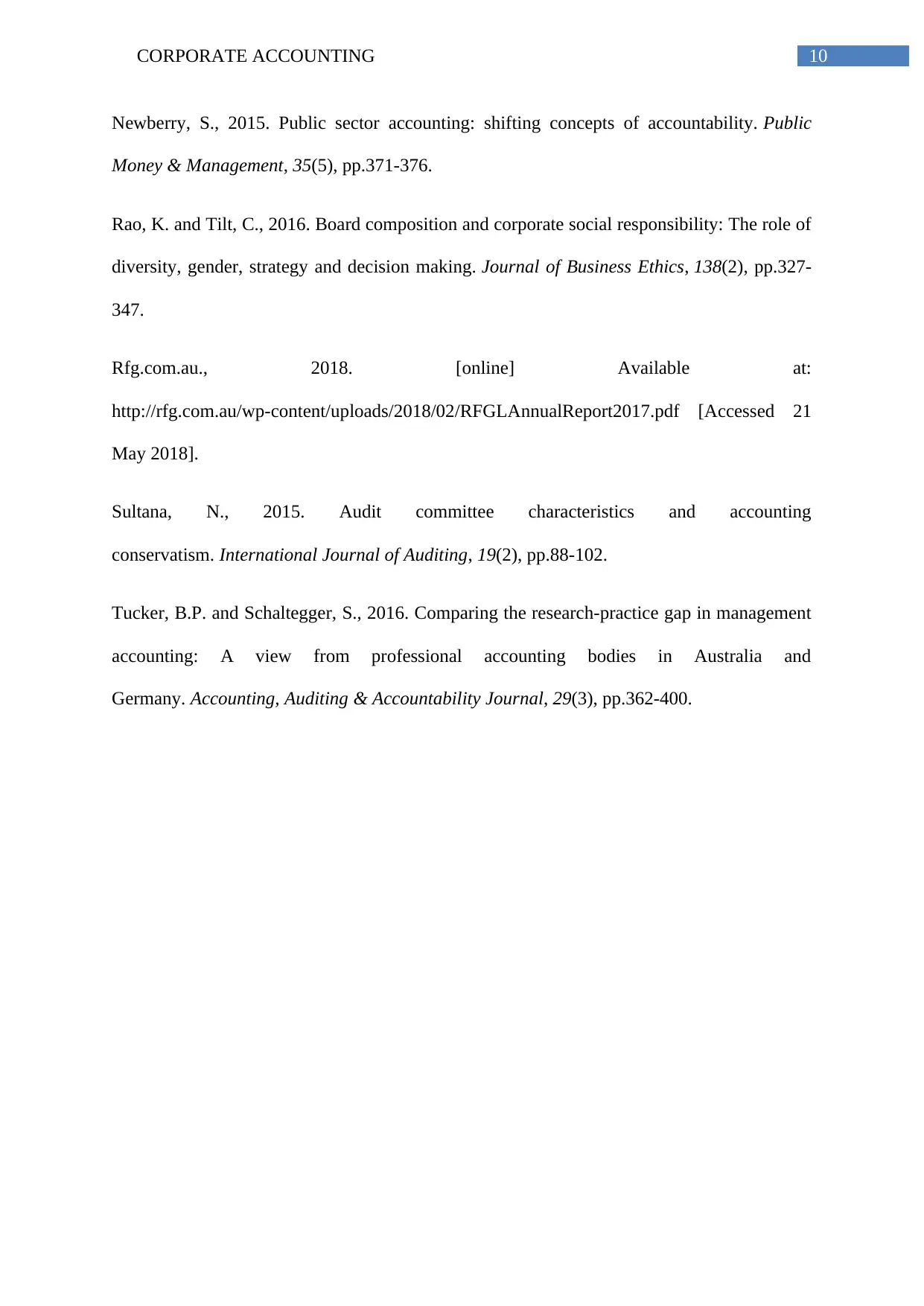
10CORPORATE ACCOUNTING
Newberry, S., 2015. Public sector accounting: shifting concepts of accountability. Public
Money & Management, 35(5), pp.371-376.
Rao, K. and Tilt, C., 2016. Board composition and corporate social responsibility: The role of
diversity, gender, strategy and decision making. Journal of Business Ethics, 138(2), pp.327-
347.
Rfg.com.au., 2018. [online] Available at:
http://rfg.com.au/wp-content/uploads/2018/02/RFGLAnnualReport2017.pdf [Accessed 21
May 2018].
Sultana, N., 2015. Audit committee characteristics and accounting
conservatism. International Journal of Auditing, 19(2), pp.88-102.
Tucker, B.P. and Schaltegger, S., 2016. Comparing the research-practice gap in management
accounting: A view from professional accounting bodies in Australia and
Germany. Accounting, Auditing & Accountability Journal, 29(3), pp.362-400.
Newberry, S., 2015. Public sector accounting: shifting concepts of accountability. Public
Money & Management, 35(5), pp.371-376.
Rao, K. and Tilt, C., 2016. Board composition and corporate social responsibility: The role of
diversity, gender, strategy and decision making. Journal of Business Ethics, 138(2), pp.327-
347.
Rfg.com.au., 2018. [online] Available at:
http://rfg.com.au/wp-content/uploads/2018/02/RFGLAnnualReport2017.pdf [Accessed 21
May 2018].
Sultana, N., 2015. Audit committee characteristics and accounting
conservatism. International Journal of Auditing, 19(2), pp.88-102.
Tucker, B.P. and Schaltegger, S., 2016. Comparing the research-practice gap in management
accounting: A view from professional accounting bodies in Australia and
Germany. Accounting, Auditing & Accountability Journal, 29(3), pp.362-400.
1 out of 11
Related Documents
Your All-in-One AI-Powered Toolkit for Academic Success.
+13062052269
info@desklib.com
Available 24*7 on WhatsApp / Email
![[object Object]](/_next/static/media/star-bottom.7253800d.svg)
Unlock your academic potential
Copyright © 2020–2025 A2Z Services. All Rights Reserved. Developed and managed by ZUCOL.




